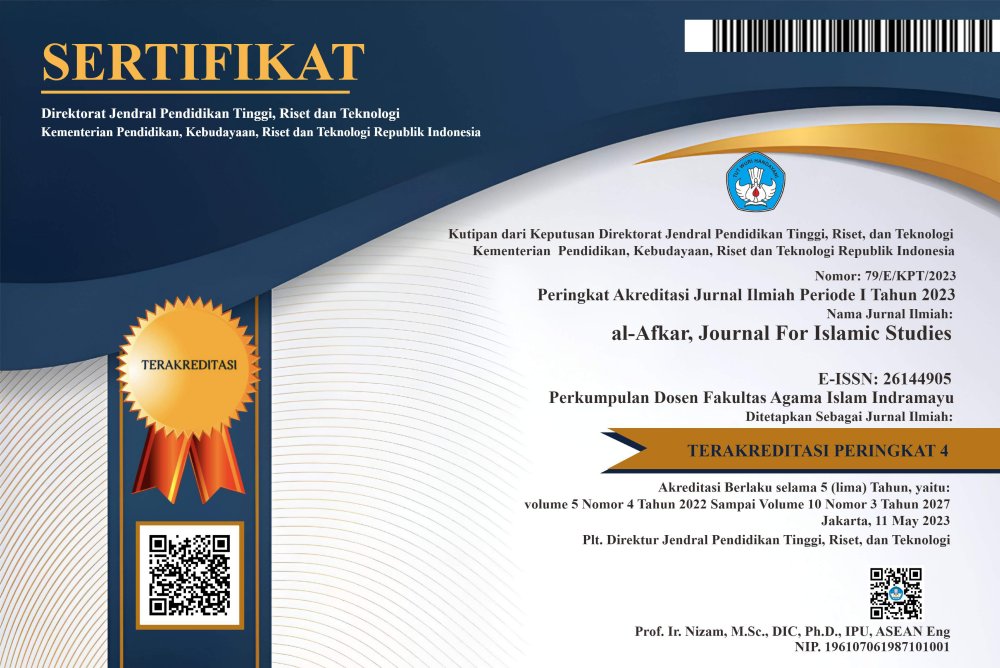Sha'rawi's Perception of Economic Solutions for Home Women in QS Al-Ahzab Verse 33 with Tahlili Approach
DOI:
https://doi.org/10.31943/afkarjournal.v7i1.905Keywords:
Women's economy, Women working outside the home, Tafsir Sha'rawiAbstract
The debate between women being allowed to leave the house or stay at home has a long discussion. There are two opposing views on this matter. Looking at the problems discussed, the author uses the tahlili approach method which focuses on the words "وَقَرْنَ فِيْ بُيُوْتِكُنَّ " (let you (women) remain in your house), which takes the view that according to Sheikh Muhammad Mutawalli Al-Sha'rawi, he is of the view that women are not allowed to work outside the home because of the many effects of slander that will occur if women do a lot of activities outside the home. In the end, it can be concluded that in the explanation of his interpretation, Sha'rawi provides alternative solutions so that women can work to meet their needs or help their household needs by making creativity or handicrafts that can be done from home and can later be sold. When juxtaposed in today's modern era, women can use social media and sell their services through social media or online, this avoids women working outside the home in order to remain responsible for their domestic work.
Downloads
References
Farah, Naila. “Hak-Hak Perempuan Dalam Islam.” Yinyang: Jurnal Studi Islam Gender Dan Anak 15, no. 2 (2020): 183–206. https://doi.org/10.24090/yinyang.v15i2.3953.
Hana, Muhammad Yusrul. “Kedudukan Perempuan Dalam Islam.” Jurnal Kajian Gender Dan Anak 6, no. 1 (2020): 1–9.
Http://repository.uma.ac.id/bitstream/123456789/180/5/128600139_file5.pdf. “Http://Repository.Uma.Ac.Id/Bitstream/123456789/180/5/128600139_File5.Pdf,” no. 1993 (2006): 14–40.
Indrawan, Deni, and Siti Rahmi Jalilah. “Metode Kombinasi/Campuran Bentuk Integrasi Dalam Penelitian.” Jurnal Studi Guru Dan Pembelajaran 4, no. 3 (2021): 735–39. https://doi.org/10.30605/jsgp.4.3.2021.1452.
Karir, Wanita, and Dalam Perspektif. “Wakirin Wanita Karir Dalam Perspektif Islam” 4, no. 1 (2017): 1–14.
Komparasi, Studi, Tafsir Fī, Ẓīlal Al, Q U R Ān, S H A Rāwy, and Tentang Hak-hak Perempuan. “Studi Komparasi Tafsir Fī Ẓīlal Al - Qur’ān Dan Al- Sha’rāwy Tentang Hak-Hak Perempuan” 2 (2022): 1–18.
Kosanke, Robert M. “Kosanke, Robert M,” 2019, 7–22.
Magdalena, R. “Kedudukan Perempuan Dalam Perjalanan Sejarah (Studi Tentang Kedudukan Perempuan Dalam Masyarakat Islam).” Harkat An-Nisa: Jurnal Studi Gender Dan Anak 2, no. 1 (2017): h. 22 26-27.
Nirwana AN, Andri. “Qawaid Tafsir Dan Ushul Tafsir Siti Aisyah Dalam Kitab Sahih Muslim.” Jurnal Ilmiah Al-Mu’ashirah 18, no. 2 (2021). https://doi.org/10.22373/jim.v18i2.11281.
Nirwana, Andri, Hayati Hayati, and Muhammad Ridhwan. “The Media of Washatiyah Dakwah in Quranic Exegesis Study.” Budapest International Research and Critics Institute (BIRCI-Journal): Humanities and Social Sciences, 2020. https://doi.org/10.33258/birci.v3i2.919.
Pahleviannur, Muhammad Rizal, Anita De Grave, Debby Sinthania, Lis Hafrida, Vidriana Oktaviano Bano, and Dani Nur Saputra. Metodologi Penelitian Kualitatif. Pradina Pustaka, 2022.
Pasya, Hikmatiar. “Studi Metodologi Tafsir Asy- Sya’rawi” 1, no. 2 (n.d.).
Rokim, Syaeful. “MENGENAL METODE TAFSIR TAHLILI.” Al - Tadabbur: Jurnal Ilmu Al-Qur’an Dan Tafsir 2, no. 03 (2017). https://doi.org/10.30868/at.v2i03.194.
Dr.Hj. Istibsyaroh,S.H.,M.A., Hak-hak perempuan, Jakarta Selatan, Penerbit Teraju, 2004
Bahasa, P. P. (2002). KBBI. Dalam P. P. Bahasa, KBII (hal. 382). Jakarta: Balai Pustaka.
Depdikbud. (2002). Kamus Besar Bahasa Indonesia. Dalam KBBI (hal. 10250). Jakarta: Balai Pustaka.
Maghfiro, N. (2021, Maret Minggu). Empat Keadaan Perempuan Boleh Keluar Rumah dalam Syariat Islam. Diambil kembali dari Bincang Muslimah: https://bincangmuslimah.com/kajian/empat-keadaan-perempuan-boleh-keluar-rumah-dalam-syariat-islam-34601/
Muhammad, A. (1982). 'AwfAl-Ahzar FI Alf'Am. Dalam A. Muhammad, 'AwfAl-Ahzar FI ALF'Am (hal. 8). Kairo,Mesir: Silsilat Al-Buhuts Al-islamiyah.
Sya'rawi, S. M. (2011). Tafsir Sya'rawi Akhbar Al-Yaum, Kairo. Dalam S. M. Sya'rawi, Tafsir Sya'rawi (hal. 809). Jakarta Timur: Duta Azhar.
Downloads
Published
How to Cite
Issue
Section
License
Copyright (c) 2024 Annisa Az Zahra, Yeti Dahliana, Andri Nirwana AN

This work is licensed under a Creative Commons Attribution 4.0 International License.



















